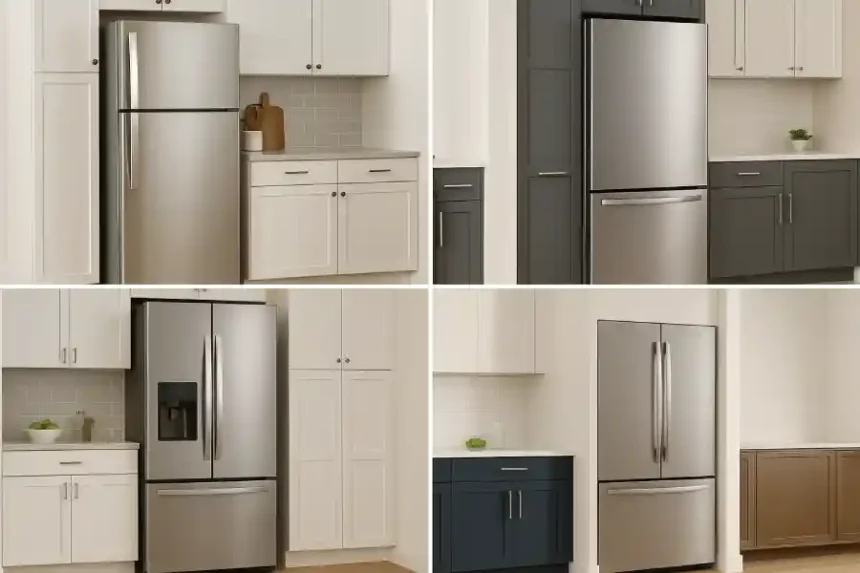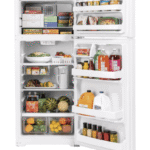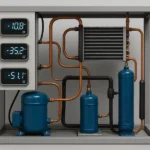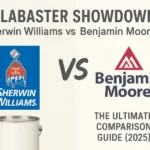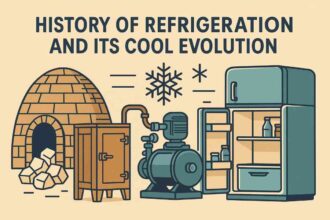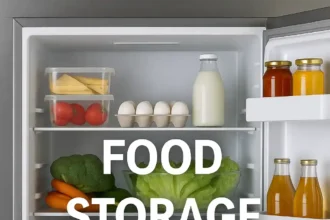Your refrigerator is the unsung hero of the kitchen. It quietly hums in the corner, keeping your late-night pizza slices cold and your morning smoothie ingredients fresh. Whether you’re a home chef or a convenience-food connoisseur, the right fridge can make or break your daily routine. With so many trends in modern living – from energy efficiency to smart features – choosing among the types of refrigerators out there suddenly feels as important as picking your dream car.
According to industry reports, nearly every American home has one of these essential appliances, and the global fridge market is booming. Allied Market Research notes that the worldwide refrigerator market was about $126.9 billion in 2022 and is expected to reach $220.6 billion by 2032. Smart refrigerators are a big reason why sales are heating up – demand has surged thanks to Wi-Fi connectivity, touchscreens, and voice control. Whether you’re in a downtown apartment or a suburban kitchen, there’s a fridge style to match your space, budget, and personal flair. For fun, Statista’s charts on the most popular refrigerator brand by country highlight how tastes differ around the world. In the sections below, we break down the main types of refrigerators – from old-school classics to high-tech showpieces – so you can pick the perfect cool companion for your kitchen.
Top Freezer Refrigerators
If you grew up in the 80s, this design probably looks familiar – the freezer is on top, the fridge below. Sometimes called a top-mount refrigerator or freezer-on-top fridge, the top-freezer layout is a classic for a reason. It’s often the most budget-friendly option, packing plenty of storage for everyday use without breaking the bank. Many homeowners love that top freezer refrigerators give you more usable fridge space for the money (the compressor sits down low and cold air naturally sinks). Reviewers often praise their simplicity and reliability.
- Pros: Affordable price tag, compact footprint (great for apartments or tiny kitchens), and generally very energy-efficient. There are even ultra-small models (around 10–14 cu.ft.) if space is tight, up to large units (20+ cu.ft.) for big families.
- Cons: You’ll find yourself bending down every time you grab milk or veggies, and freezer drawers can be awkward to reach. These fridges tend to lack bells and whistles – built-in ice makers are rare, and lighting/organization is basic.
Quick Tip: For a highly-rated small top-freezer fridge, check out the GE 17.5 cu. ft. Top-Freezer Refrigerator GTS18HGNRWW. It’s compact and efficient, making it great for kitchens where space is at a premium.
Below is a quick comparison chart highlighting how top-freezer models stack up against bottom-freezer designs:
| Feature | Top Freezer | Bottom Freezer |
| Accessibility | Fridge items are lower; you need to crouch. | Fridge at waist/eye level; easier access. |
| Fridge vs Freezer Space | More fridge area (freezer smaller). | More freezer capacity (fridge a bit smaller). |
| Price | Generally cheaper. | Generally pricier. |
| Energy Efficiency | Often slightly more efficient (gravity helps). | Efficient, but the fridge works harder. |
| Features | Basic setup; fewer extra features. | Often include ice/water dispensers and advanced lighting. |
You’ll notice we slipped in that top freezer refrigerator pros and cons list and comparison – these classic fridges may not have the flashiest features, but their old-school charm and efficiency still make them a contender for many buyers.
Bottom Freezer Refrigerators
Flip the top-freezer design upside-down and you get a bottom-freezer layout, sometimes called a bottom-mount refrigerator or freezer-on-bottom fridge. In this configuration, your fridge goodies are right at eye or waist level, and the freezer is tucked below. Many folks love this modern layout because it keeps the most-used fridge shelves accessible without bending over. It’s a common style in medium to large kitchens and often comes packed with features.
- Pros: Easy access to refrigerator items (no more crouching!), and often the fridge section is slightly bigger than its freezer. Many bottom-freezers have a crisper or deli drawer at a convenient height. Features like ice/water dispensers are more common on bottom-freezer models.
- Cons: You’ll still need to bend down for frozen foods, and the lower freezer compartment can be a bit awkward to organize (especially the bottom-most bins). These fridges can be pricier than basic top-freezer units, and the layout may shrink fridge space slightly to accommodate that freezer drawer.
Model Highlight: If you need loads of storage, check out something like the Whirlpool 22 cu. ft. Bottom-Freezer Refrigerator WRB322DMBM. It offers a roomy fridge on top (complete with a handy snack drawer) and a well-organized pull-out freezer on the bottom – great for big families.
Side-by-Side Refrigerators
Side-by-side refrigerators split the fridge on one side and freezer on the other – picture two tall doors opening from the middle. This layout is sometimes simply called a side by side fridge freezer. The big perk? You get instant access to both fridge and freezer with minimal bending, and each door is narrower (great if kitchen space is tight). Many side-by-sides come loaded with features like built-in water and ice dispensers right in the door.
- Pros: Balanced storage: you can stash leftovers and ice cream at eye level equally easily. The slim doors mean you never need much clearance space. Features galore – models often include digital displays, auto-dispensing water/ice, and adjustable shelves. They also tend to handle large capacities (20+ cu.ft.), making them great for families who need tons of fridge room.
- Cons: Because the interior is divided vertically, wide platters or pizza boxes might struggle to fit. You typically sacrifice some fridge width for more freezer (or vice versa), so one side can feel cramped. Also, more high-tech features can mean a higher price. And beware: the tall doors can let cold air escape more easily if left open.
Example Pick: The LG 27 cu. ft. Side-by-Side Smart Refrigerator LRSOS2706S is a popular model that shows off this style. It offers a huge 27 cu.ft. of space, a touchscreen control panel, and LG’s smart fridge apps. It even has an in-door ice maker and water filter – a prime example of modern side-by-side convenience.
French Door Refrigerators
Think of a French door refrigerator as the upscale cousin of the bottom-freezer model. It usually has two doors opening to the fresh-food section on top and a pull-out freezer drawer on the bottom. Sometimes called a double door refrigerator or multi-door refrigerator, the French door style is all about wide-open space and convenience. This design gives you extra-wide shelves (no center divider in the fridge section), making it easy to fit large platters or party trays. Plus, the bottom freezer is often a roomy pull-out drawer for easy organization.
- Pros: Maximum fridge space – double doors mean a big horizontal layout with plenty of glass shelves and door bins. Many French doors have high-tech features like dual ice makers, in-door filtered water, and flexible temperature zones. It’s easy to see everything at eye level, which reduces wasted energy (only one door open at a time).
- Cons: These models tend to be heavy and pricey. You need wider clearance for the big doors, and the bottom freezer drawer can still make you squat to reach deep bins. If budget is tight, you’ll pay extra for all these bells and whistles.
Featured Model: The Samsung 28 cu. ft. Large Capacity 3-Door French Door Refrigerator RF28T5001SR is a great example. It offers a spacious 28 cu.ft. capacity, an internal filtered water dispenser (no exterior hole needed), and a convertible drawer that can act as either fridge or freezer. It’s stylish, smart, and built for entertaining – just what you’d expect from a modern French door design.
French-door fridges have dominated popularity charts for a reason: they combine style and function for entertaining and everyday life. Be sure to compare models (some are Energy Star rated, some have Wi-Fi apps) and don’t forget to measure that doorway before delivery!
Compact Refrigerators
When square footage is scarce – think dorm rooms, offices, or tiny kitchenettes – a compact (or mini) fridge might be your best friend. These small refrigerators (often just 2–4 cu.ft.) prioritize portability and affordability over space. You won’t fit a Thanksgiving turkey inside, but you can chill snacks, drinks, or an essentials stash without monopolizing the entire kitchen. Some even include a tiny freezer compartment for ice trays.
- Pros: Super space-saving and usually quite inexpensive. They’re great as a second fridge for drinks in the garage, or a mini fridge for an office cubicle. Many models have reversible doors and adjustable shelves, letting you customize the limited space.
- Cons: Limited capacity means you can’t store large items or a lot of food at once. Cooling performance can be weaker than full-size fridges when packed full. These units often have fewer features – expect manual dials instead of digital controls, and smaller (or no) freezer sections.
Recommended Model: The Midea WHS-87LSS1 Compact Refrigerator is a popular pick. It’s a 2.4 cu.ft. stainless-steel mini fridge with a reversible door and a small freezer compartment. Perfect for dorm life or as a beverage center, it’s very affordable and fits almost anywhere.
In short, mini and dorm fridges excel at doing a little job in a little space. They’re ideal for college dorm rooms, home offices, or man caves where comfort food needs a cold home – just don’t expect them to replace your kitchen fridge anytime soon.
Built-In Refrigerators
Built-in (or integrated) refrigerators are the luxe option for designers and serious foodies. These fridges are installed flush with your kitchen cabinets, often with custom paneling so that you barely notice them in the room. They come in large sizes (think 30–48 inches wide) and use beefy compressors for restaurant-grade performance. The upside? Professional styling and precise cooling for a sleek, seamless kitchen look.
- Pros: Top-tier quality and features: think advanced air filtration, dual compressors (one for fridge, one for freezer), and premium temperature controls. The flush built-in design is gorgeous and can be covered with cabinetry to match your kitchen. Many have stainless-steel interiors, UV lighting for produce, and other fancy tech.
- Cons: Ouch, the price. These are expensive – often several times more than a freestanding model of similar capacity. Installation is complex (they typically require professional installation and proper ventilation). They also eat up valuable cabinet space (especially counter-depth models built into walls).
Mentioned Model: A classic example is the Sub-Zero 36” Built-in Over-and-Under Refrigerator/Freezer. Sub-Zero is famous for this category: their models offer dual refrigeration (independent cooling circuits for fridge/freezer), stainless steel finish, and a built-in look. Yes, they cost a small fortune, but if you’re designing a high-end kitchen and want the best performance and style, this is the fridge to beat.
In essence, built-in fridges are for those who want their fridge to blend into the kitchen like a piece of cabinetry. They’re stunning, but only really make sense if you have a big budget and want a custom kitchen feel.
Counter-Depth Refrigerators
If you love the look of a built-in but want to save a bit of cash, consider a counter-depth refrigerator. These are sometimes called shallow depth refrigerators because they are about the same depth as your countertops (typically ~24–27 inches), so they don’t jut out into the kitchen. Many are French-door style, maximizing width while keeping the sleek, built-in look. A good counter-depth fridge sits flush with your cabinets and trim, instantly upgrading the room’s design.
- Pros: Stylish and space-smart: they create a seamless, professional kitchen vibe without custom cabinetry. You get easier traffic flow (no big box sticking out) and still a roomy interior (often ~20–22 cu.ft. in a 36″ model). Brands like Bosch and KitchenAid specialize in counter-depth models with high-end finishes.
- Cons: You’ll sacrifice total capacity compared to a standard-depth fridge (by a few inches of depth), so you fit less overall. They’re also more expensive per cubic foot. Because of their design, some counter-depth models have tighter shelves or may lack an internal water line (so no built-in ice maker on some units).
Our Pick: The Bosch 800 Series Refrigerator 21 cu. ft. Counter-Depth French Door is a top choice in this category. It has 21 cu.ft. of space in a sleek stainless package, with water and ice in the door. Bosch is known for quiet, energy-efficient compressors, so it’s a solid investment in a modern kitchen.
In short, counter-depth fridges give you the illusion of more space and a flush look, ideal for contemporary layouts. Just remember: a slim footprint means slightly less storage, so balance style with your storage needs.
Conclusion
No matter which style you pick – top freezer, bottom freezer, side-by-side, French door, compact, built-in, or counter-depth – each refrigerator type has its own strengths and trade-offs. The key is choosing the one that fits your space, your habits, and your vibe. Top-freezer fridges are simple and efficient, bottom-freezers keep fresh food at eye level, side-by-sides balance fridge/freezer space, and French doors offer extra style and capacity. Compact units save space in tiny rooms, while built-ins and counter-depth models give your kitchen a sleek, high-end look (for a price).
Ultimately, the best refrigerator is the one that keeps your ingredients cold and your kitchen happy. If you found this guide helpful, feel free to share it with a friend or on social media. For more fridge-related info, check out our guide on safely recovering refrigerants from old appliances and our 7 Common Refrigerator Repair Problems and Their Solutions. Stay cool, and happy shopping!

